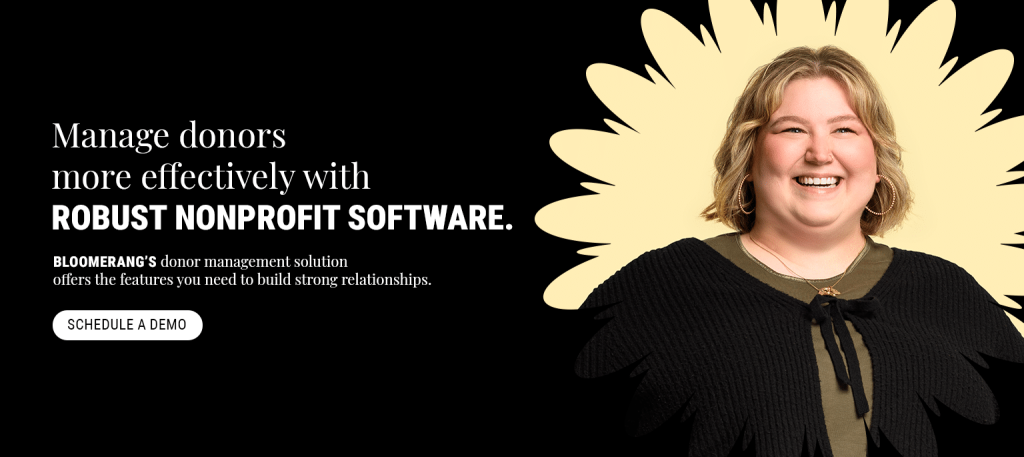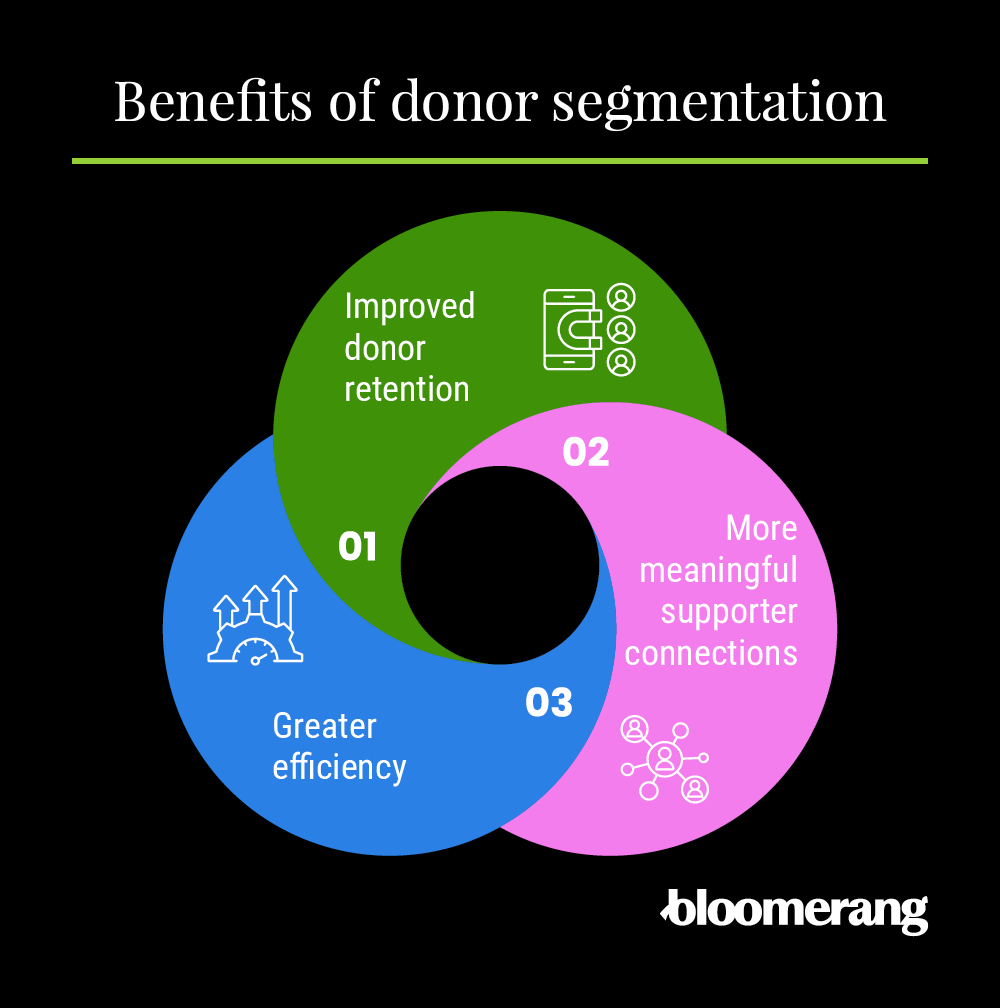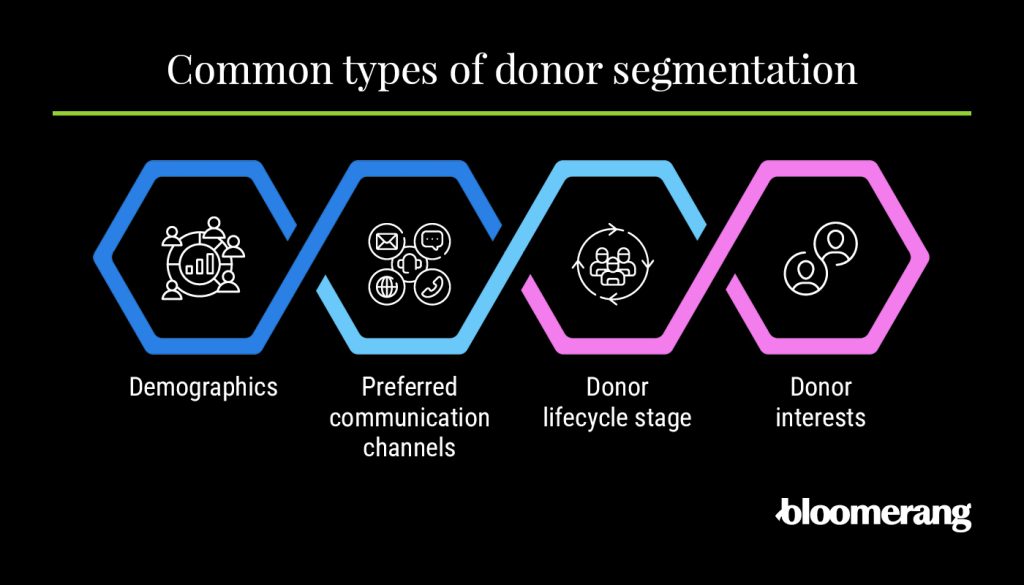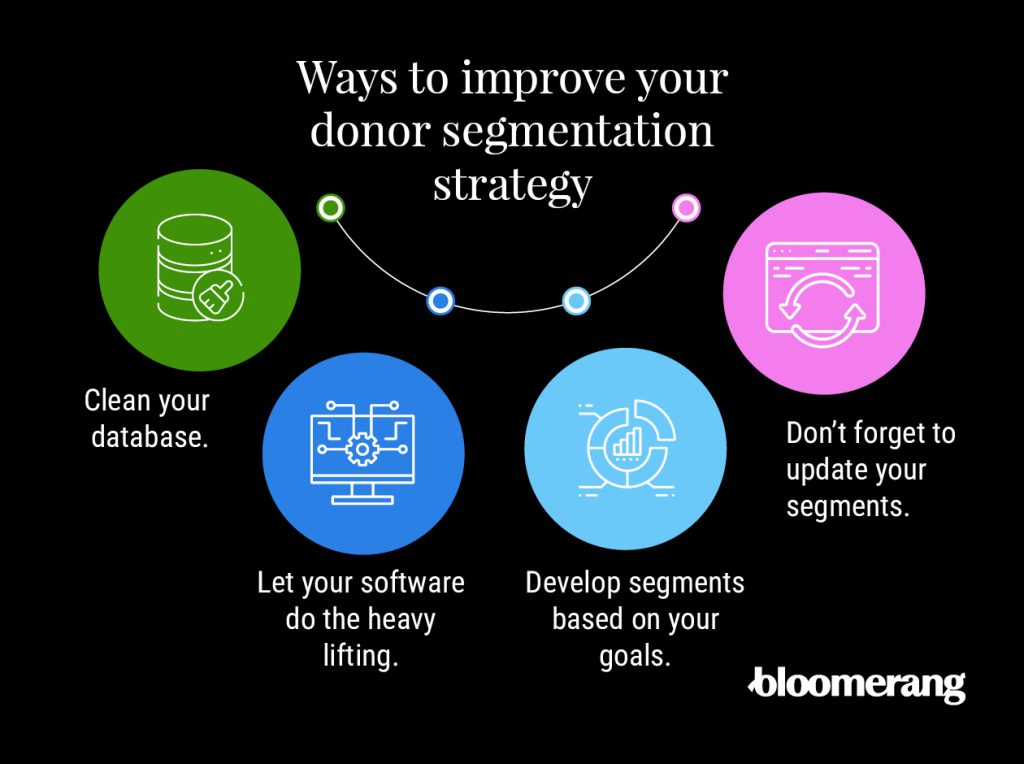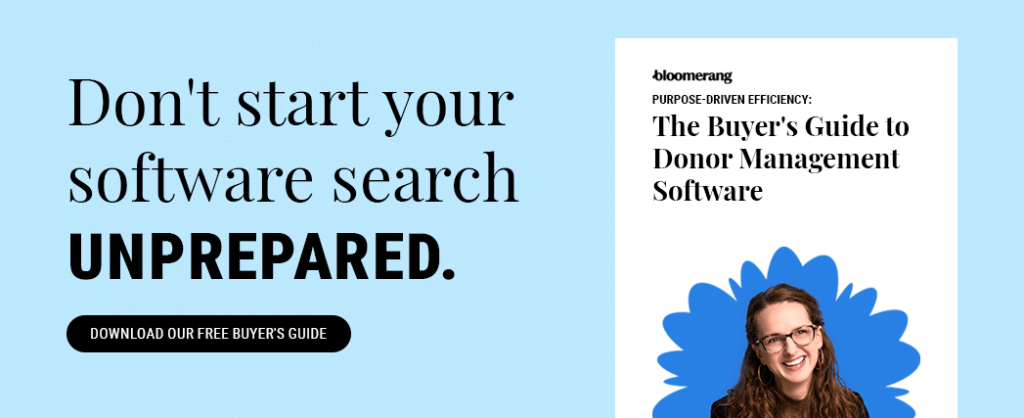Nothing makes a donor feel recognized and appreciated quite like personalized communication from your organization. It’s a great way to signal to your supporters that you value them for so much more than just the financial support they provide for your cause.
But the more donors your nonprofit recruits, the more challenging it can be to provide those individualized connections. One way your team can maintain a personal touch with your donor communications is by using donor segmentation—organizing your donors into groups based on commonalities and tailoring your messaging for each segment.
If you’re wondering how your organization can benefit from donor segmentation, this guide will help you develop your strategy and take your communications to the next level:
- What is donor segmentation?
- What are the benefits of donor segmentation?
- What information should you collect for donor segmentation?
- What are the common types of donor segmentation?
- How can your organization use donor segments?
- How can you improve your donor segmentation strategy?

What is donor segmentation?
Donor segmentation is a method of categorizing donors into distinct groups based on shared characteristics. By analyzing donor profiles, finding similar traits, and grouping supporters accordingly, you can provide more personalized interactions for each donor segment.
What are the benefits of donor segmentation?
The benefits of donor segmentation include:
- Improved donor retention. Generic communications can leave donors feeling unappreciated, so adding personal touches through donor segmentation can help keep your supporters motivated to give. By engaging your donors with tailored messaging, you’ll inspire them to maintain their support and continue giving to your mission.
- More meaningful supporter connections. Donor segments enable you to craft messages tailored to your donors’ giving patterns, while also creating opportunities to connect with your supporters beyond donations. For example, if you know there is a donor subset interested in volunteering, you can send them relevant volunteer opportunities.
- Greater efficiency. With donor segmentation, you can more quickly and easily reach targeted audiences. This process saves time your team may have otherwise spent contacting individual supporters, allowing you to focus more energy on mission-critical tasks.
As your organization grows, donor segmentation empowers you to maintain strong connections with supporters while also freeing your team to focus on other activities.
What information should you collect for donor segmentation?
A significant amount of the information you need to segment your donors is already stored in your database. You likely already collect donor data directly through your online giving form, event registration pages, or surveys. This information may include:
- Name
- Contact information
- Donation size
- Donation date
- Events attended
- Communication preferences
- Interests
Store this information securely in your nonprofit’s constituent relationship management platform (CRM). The more donor data you collect, the more opportunities you’ll have to create donor segments that power stronger personalization.
What are the common types of donor segmentation?
There are several ways to group your supporters for effective donor segmentation. Let’s explore some of the top criteria nonprofits use for this process.
Demographics
Categories of demographic data you can reference to create donor segments include:
- Age: Not all social media platforms attract the same age groups. Grouping your donors by age helps you tailor your messaging to the specific platform where your donors are spending their time. Age can also tell you the most likely way your supporters will donate to your organization. For example, research shows that Gen Z is the generation most likely to give via digital wallet, while Baby Boomers are the most likely to give via check.
- Location: Promote in-person events and volunteer activities based on donors’ local areas. Location data can also help you determine who to contact during geographic-based crises, such as hurricanes or wildfires, and which donors will be directly impacted.
- Income: A donor’s income can directly affect their giving capacity. Segmenting your donors by income helps you choose who to market different levels of giving to.
- Family status: Family status can affect which events and campaigns your donors are more likely to interact with, depending on your cause. For instance, you may host a family-friendly carnival fundraising event and reach out to families with children to promote the event.
Preferred communication channels
Segmenting your donors by their preferred communication channels provides a better chance they’ll respond to your campaigns, maximizing your fundraising and stewardship efforts. These channels may include:
- Email: For donors who prefer to be contacted through email, you can use longer storytelling appeals and link directly to your donation form. You can also automate your emails for donor acknowledgments after a campaign, speeding up the process of showing donors your appreciation.
- Social: If your donors prefer engaging with your social media posts, guide your followers to your organization’s website through these posts. You can also take advantage of social media ads to further increase your posts’ visibility. Social posts are also a great way to publicly appreciate your donors.
- Direct mail: Some of your donors may prefer the more personalized feel that direct mail provides for fundraising appeals and thank-you letters. Additionally, direct mail has the highest return on investment (ROI) among individual media, at 161%. You can include QR codes that link to your online donation form, provide campaign updates, or offer ways for them to donate in person.
- Phone: Phonathons and text fundraising are often effective ways to ask for donations because most donors have their mobile phones wherever they go, enabling them to donate whenever they like. Phone calls can also provide a nice personal touch when thanking your donors for their support.
Donor lifecycle stage
The donor lifecycle refers to the journey donors undergo as they learn about your organization, become contributors, and continue lending their support. Grouping donors by their existing relationships with your nonprofit allows you to customize your communications to shine a spotlight on the impact they’ve had on your mission. The types of data that can be useful for this type of segmentation include:
- Giving history: How frequently a donor gives to your organization can help you determine how often your team should reach out for fundraising appeals and donor stewardship efforts to achieve the most effective results. According to the Fundraising Effectiveness Project, nonprofits have only retained 7.1% of new donors year to date and 25.4% of repeat donors year to date as of Q1 2025, so creating a segment for new donors can help you focus your retention efforts on this group to secure further donations.
- Types of donations: A recurring donor, an annual donor, and a major donor should all have separate appeals and acknowledgments that recognize their impact on your mission. For example, you may send a recurring donor a monthly recap email highlighting the impact their contributions have made on your cause, whereas you may call a major donor every quarter to provide them with updates on the difference they’ve made.
- Donation amount: Grouping your donors by their donation amount allows you to tailor your appeals to each donor’s personal giving experience, without asking for too much or too little. Make realistic upgrade asks that align with donors’ giving capacities.
Donor interests
Each donor is unique, and the specific aspect of your mission that motivates them to give varies from person to person. Often, these interests are what led these donors to your organization in the first place. When you segment your donors by interest, you can use the part of your mission they’re most passionate about to make your communication efforts more engaging, such as:
- Sub-causes: Many nonprofit causes have multiple components that resonate with donors, and you can use those elements to tailor your communications. For example, a donor to an environmental organization may prefer focusing on conservation efforts rather than pollution prevention.
- Specific projects: Similar to the different facets of a cause, you can also segment your donors by the specific projects they fund to target your appeals accordingly. Some of your donors may prefer to donate to construction funds, while others prefer to give to actionable initiatives.
- Values: A significant aspect of soliciting donations is creating an emotional appeal. To do this effectively, you must know what your donors value when giving to a nonprofit. Grouping your supporters by their values lets you more effectively appeal to their emotions. For instance, you can create a segment for donors who connect more with heart-warming stories and another for donors who are more inspired by seeing the data behind your success.
- Events attended: Events provide a great opportunity to recruit new donors, and grouping the donors you recruit through events helps you know who to promote your future events to. You may further segment donors based on the specific types of events they prefer, whether that’s by event location (virtual, hybrid, or in-person) or content (fundraising, advocacy, or educational).
- Volunteering: If your supporters are unable to contribute financially to your cause, they may volunteer instead. Creating a segment for your volunteers lets your team know who to contact when they could use an extra hand. Volunteers are highly engaged with your mission and may become donors in the future.
How can your organization use donor segments?
Once you’ve grouped your donors into segments, you can start using them in your communication strategy. There are a few ways you can use your donor segments to boost your organization’s fundraising and donor retention:
Fundraising appeals
Tailor your fundraising appeals to different donor segments by creating templates for various donor groups. Developing customizable templates can help you save time when personalizing your messaging to each segment during your fundraising campaigns. A personalized fundraising appeal is more likely to entice your donors to give because you can leverage your donors’ previous experiences with your organization.
For example, here’s what your fundraising appeal template might look like for your recurring donor segment:
Dear [Donor Name],
We truly appreciate your continued support at the Ocean Rescue Foundation. Without your monthly donations, we wouldn’t be able to lead regular cleanups, educate the community about ocean preservation, and help protect wildlife.
Right now, we’re running our [insert campaign name and explanation]. In addition to your generous monthly contribution of [insert donation amount], would you be willing to lend a little extra support?
Stewardship
Donor stewardship is crucial to retention, and segmentation helps you make your donors feel more appreciated by recognizing the specific impact they’ve made on your cause. Whether sending acknowledgments to your donors privately or publicly, you can customize your thank-you messages to your donor segments based on the type of donations they’ve made previously. You can also use your segments to thank your volunteers, event attendees, or sponsors.
Consider this example tailored to first-time donors:
Dear [Donor Name],
Thank you for contributing your first gift to our organization! It’s always touching when someone discovers our cause and feels passionate about it to donate, so thank you from the bottom of our hearts here at Animal Rescue Central.
Donating isn’t the only way to get involved in our nonprofit. Explore the volunteer opportunities listed below, and follow our social media accounts to stay up-to-date on our latest events and activities.
While this template welcomes new donors to your organization and encourages them to deepen their involvement, an example for a major donor may look more like this:
Dear [Donor Name],
Thank you for your continued generosity. Your recent $5,000 donation will enable our team to provide critical care to dozens of incoming animals before they find loving homes.
We’d love to acknowledge your contribution with a spotlight in our upcoming monthly newsletter. Please let us know if you’re open to this opportunity, and we’ll arrange an interview.
How can you improve your donor segmentation strategy?
Once you’ve chosen which donor segments will work best for your nonprofit, you can start implementing processes to maximize your results. Use these tips to set your strategy up for success.
1. Clean your database.
Since you’ll base your segmentation strategy on the donor data you’ve stored, you’ll need to ensure it’s up to date and accurate. Keep your database clean by:
- Conducting regular audits to identify inaccurate, outdated, or duplicate information.
- Standardize data entry to ensure all data is uniform.
- Appending missing data that could help you develop more precise segments.
By practicing proper data hygiene, you can more easily create segments and ensure your messages reach the right supporters.
2. Let software do the heavy lifting.
Your fundraising software and other software integrations are crucial to your donor segmentation system, as that’s where you collect and store all donor information. Software can help you automate the process of grouping your donors using different filters and sending them relevant communications.
Your software can also track the impact of your donor segmentation efforts. By monitoring metrics, such as email open rate, conversion rate, and retention rate by segment, you can assess which of your messaging techniques are most effective. Once you identify which techniques are successful, you can refine them to replicate your previous results and modify any techniques that aren’t engaging your donors.
3. Develop segments based on your goals.
Creating segments haphazardly can waste your team’s time and energy. Instead, focus your efforts on donor segments that will help you achieve your goals.
For example, a nonprofit that runs a mentorship program may create a segment for former mentees to keep them involved in the organization and eventually ask them to become mentors. Meanwhile, a political advocacy organization may group donors based on the legislation they typically support.
4. Don’t forget to update your segments.
Your personalized communications won’t work if your donor no longer belongs to the group you’re trying to connect with. For example, if a one-time donor contributes a major gift, they’ll no longer resonate with messages welcoming them to your organization for the first time.
Establish a schedule for your team to review your segment lists regularly to keep them up to date. Consider surveying donors regularly to ensure your segments continue to accurately reflect their interests and preferences.
Final thoughts
Donor segmentation enables your organization to provide personalized touches in your communications with donors, demonstrating your appreciation for their support. As a result, you’ll build deeper relationships with your supporters and retain them as part of your community for years to come.
Of course, strong donor segmentation starts with a comprehensive CRM that allows you to store and organize donor data accordingly. Bloomerang CRM gives you a 360-degree understanding of every supporter so you can segment donors and personalize your communications with them. Book a demo today to explore our award-winning platform.
To learn more about building donor relationships, explore these additional resources:
- How to work smarter, not harder, with fundraising automation. Automation can streamline donor segment creation. Explore the ins and outs of fundraising automation.
- How to write a meaningful donor thank-you letter. Segmenting your donor base allows you to deliver meaningful donor thank-you letters. Discover additional ways to strengthen your supporter appreciation.
- How to create a donation page that catapults fundraising. Your donation page allows you to collect a variety of donor data for segmentation. Learn how to optimize this crucial page on your website.
